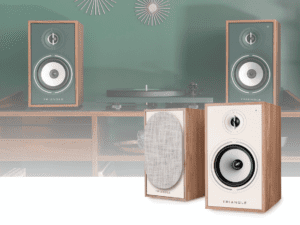
The landscape of consumer electronics forever changed with the rise of the personal computer. Where once we set our clock by the lifespan of a TV or even a toaster, we now figure our replacement cycles for consumer electronics by the workable life expectancy of a computer. Although these cycles have slowed in the 21st Century (users today keep their computers for three to five years), the lifespan of a computer is still considerably shorter than the lifespan of a traditional audio product. A ten year old laptop is geriatric, but a ten year old preamplifier is still in its prime.
For some aspects of audio, new is good. Aside from paraphrasing Jefferson (“the tree of audio must be refreshed from time to time by the cash of enthusiasts and newcomers”), those requiring digital streaming, networked audio, or the latest in a regularly refreshed range of digital audio formats all need to have equipment that keeps pace with the technology, which usually means a steady stream of new products, or at least products with provision for periodic software and firmware updates. However, even here the demand for novelty is not as profound as might first be expected, and there are still many enthusiasts extracting a lot of musical enjoyment from discontinued Slim Devices and Logitech Squeezebox products. But generally, if you swim in the digital ocean, you need to come up for air regularly.

When it comes to most other aspects of audio, it’s worth remembering that our hobby is the most mature branch of consumer electronics out there. Although there are always new developments in engineering and materials science, measurement, and innovative construction techniques, most of the groundwork in audio was completed decades ago, and the difference between a good preamplifier of 15 years ago and a good preamplifier today are fairly subtle. We do have additional strata of excellence that did not exist decades ago, and the difference between a good amplifier of 15 years ago and an outstanding amplifier of today can be significant, but often at a cost.
This can give rise to stagnation in sales of new equipment: the biggest rival for many audio brands with a legacy and a reputation for producing extremely well-made and reliable equipment is their past. And that stagnation can lead to panicked manufacturers, distributors, and retailers spreading FUD about older products.
One aspect of modern audio is it is expensive enough to allow companies to factor for long product lifespans, and make products designed to last decades without failure or repair. This makes no sense to those more used to the life cycle of a typical PC or digital camera, and there is a tendency to dismiss any product made before about 2002 as ‘worthless’, or ‘about ready to fall apart’. This is nonsense. That classic Audio Research preamp with a Krell power amp combination in the mid 1980s might be a little tired now, and it might be old-fashioned in both sound and layout (who buys shin-breaking heatsinks like that now?), but ‘worthless’?
Yes, it’s true that electronic components age, and over time their initial ratings and tolerances become little more than a faded memory. And yes, eventually, this process means the product either requires a significant rebuild or, if that is not economically viable, complete replacement. But, typically such rebuilds are only worth considering after 20-30 years of service. Sometimes far longer.
We are in a world of change here, too. The move from full-sized, hand-soldered components to tiny, machine-fitted surface mount devices (SMD) has been driven once more by the computer industry, and permeates much of today’s audio electronics. The obvious advantage to switching to SMD is greater initial reliability and longer mean times between failures of circuit boards. However, repairing or replacing aging components on an SMD board is considerably harder and more time-consuming than a conventionally ‘stuffed’ board. We don’t know the long term aging and life-cycles of these products yet, in part because most SMD boards in domestic service are disposed of before the product reaches its tenth birthday.
There are no easy answers here though. As a rule of thumb, I think anything that connects to a computer has five to 10 years of working life before it approaches redundancy. Regardless of whether or not the computer-side product features compatibility issues due to age, the electronic components in that device should last at least 10-25 years without need for major repair or rebuild, as they should for any device with no moving parts. Components that spin a disc can vary in longevity; there are still unserviced turntables from half a century ago still working perfectly, and there are CD transport mechanisms from the 1990s that are now basically played out and irreparable. Transducers too vary in terms of life expectancy, but more to do with their potential for damage; typically, thousands of hours of playing records are expected from a cartridge, and the life expectancy of a typical loudspeaker cone is measured in decades.
As a member of the audio press, I can’t help feeling at least in part responsible for this constant drive for the newest and latest. Writing about audio in today’s market often has the tang of the proselytiser about it, because we are often seen as trying to persuade people to buy new versions of things they already own. In part though, this cuts both ways; part of the demands placed on a reviewer in any field is their personal benchmarks remain current, so we seem to recommend an ever-changing sea of products in our own systems. But the reality is most systems tend to sound better than a typical reviewer’s set-up, simply because they are fixed in place.
Tags: FEATURED
By Alan Sircom
More articles from this authorRead Next From Blog
See all
Audio Show Deluxe 2024: A photo show report
- Mar 28, 2024

Paul Messenger 1949-2024: A personal tribute
- Mar 26, 2024

Bristol Hi-Fi Show 2024: See You There!
- Feb 21, 2024

Triangle Borea Connect
- Feb 19, 2024










